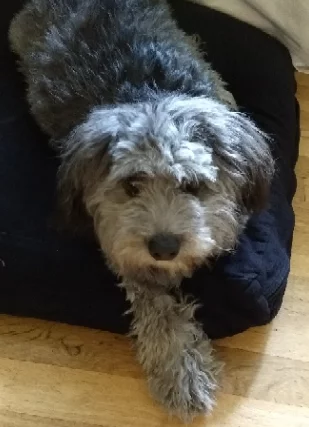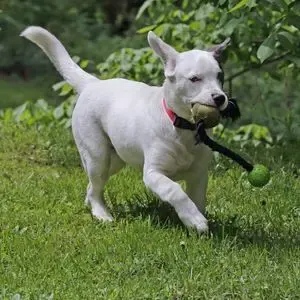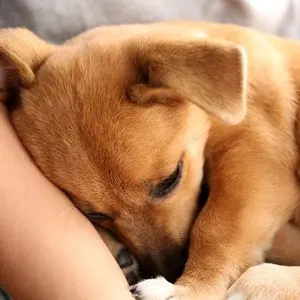Search on separation anxiety in dogs and you will find a ton of articles on the subject.
It seems to be a growing issue for many dogs and their owners.
Growing up we had a total of four dogs. For a few years we had three dogs at once but most of the time there was only one dog in the house.
They were all different breeds. We had a Siberian Husky who loved to run, a German Shepherd, and a mutt we rescued from the streets.
We also had a Belgian Shepherd who watched over me, her flock, very carefully.
As an adult, my husband and I had two dogs which we adopted at various ages.
All of the dogs in my life stayed at home by themselves at some point during the day.
None of them had separation anxiety. That is until our newest pup, Bella.
Now, I am not saying separation anxiety in dogs didn’t exist in the past. Just because we didn’t have issues with it, that doesn’t mean it didn’t happen. But I do feel that it is more common now.
Join us as we discuss some of the possible causes of separation anxiety in dogs and some practical ways to prevent it from starting.

What is Separation Anxiety in Dogs?
Separation anxiety in dogs is a condition where a dog will become stressed when their family leaves them alone. The stress can cause the dog to bark, cry or become destructive to their environment or themselves.
What Causes Separation Anxiety in Dogs?
There is no single cause for separation anxiety in dogs. All dogs are different and what trigger the condition with vary too.
However, it is believed that a traumatic experience in a dog’s life may be the cause for many dogs. For dogs that find themselves in a shelter, it makes sense that they may have had a traumatic experience in their past that is causing the anxiety.
A dog that was dumped by their previous owner will worry that their new family will leave them.
Same thing goes for a dog that was abused or had to fend for themselves on the streets. They may worry about losing the comforts of their new home.
For a dog that did not experience a traumatic event in their life, a change in routine could be the cause. Dogs are creatures of habit. If anything changes in their daily routine or their lives, they can become stressed. Changes like someone leaving their family or a change in where they live can trigger separation anxiety.
But it seems that even dogs without the trauma or change in their lives can still end up with separation anxiety. This is the category our pup fell into.

Our Story
When we were looking for a dog to adopt we found that many of the rescue groups required that someone was home during the day.
Since we were looking for a puppy this time around, we didn’t think twice about the requirement. We knew a puppy needed a lot of attention in their first year.
However, I think we took the requirement a little too far. We had arranged our schedules so that Bella was never alone. On one hand she potty-trained really quickly.
But on the other hand when we finally did need to leave her alone she was not used to it. The first time we left her alone she put up the biggest fuss I had ever seen.
She cried, barked and howled so loud that you could hear her outside of the house. Even with all the windows closed.
Since she was too young to be loose in the house we had placed her in the crate. That meant she couldn’t be destructive, but she did throw herself against the crate trying to get it open. I was worried that she would hurt herself.
It was at that moment that I realized we had spent a lot of time socializing her with new people, places and animals but we never thought that she needed to be taught how to be alone.
But it did make sense, if she was never alone before why would she want to be alone now.

Signs of Separation Anxiety in Dogs
According to the American Kennel Club if your dog exhibits some or all of these behaviors when you leave them alone or when you are preparing to leave, they may be suffering from separation anxiety.
- Excessive barking or howling
- Destructive Acts, like chewing the furniture or clothing
- Frantically scratching on doors and windows to get out
- Indoor ‘accidents’ when they are fully house trained
- Intense pacing
- If crated, escape attempts so desperate, the dog may actually harm themselves.
- Although not part of the AKC list
- Excessive drooling and
- General nervousness can also be signs.
Do Puppies Grow Out of Separation Anxiety?
Generally a puppy will not grow out of separation anxiety on their own. Learning to be comfortable when left alone is an important life skill that all puppies need to be taught.
It should be part of every puppy socialization checklist but it is often overlooked. You should start to teach your pup how to be alone before they are 3 months old.
If you start young, your puppy should grow up to be a confident dog that is ok with being left alone for short periods of time.
But remember dogs are social animals. They want to be around people or other animals. Even a well-adjusted dog will become lonely if left alone too often.
If you are unable to be with your dog for large periods of time consider sending them to doggy day care or get a dog walker so they can interact with other dogs and people.
Is it Really Separation Anxiety?
Poor behavior can be caused by the stress your dog feels when you leave them alone. But not all bad behavior is due to separation anxiety.
Sometimes a dog is just bored and has too much pent up energy. In these cases it is not an emotional response to being alone but just them trying to entertain themselves.
Also there are medical issues that can cause your dog to eliminate in the house. If your dogs is having ‘accidents” when you are not home, you may want to visit your vet to make sure they are ok.

How to Stop Separation Anxiety Before it Starts
As I have already mentioned the best way to stop separation anxiety before it starts is to teach your puppy to be comfortable with being alone at a young age. Here are a few simple tricks to get you started.
Give them plenty of exercise before leaving them alone
A tired pup is a happy pup. The biggest mistake people make is leaving a puppy that is full of energy alone. This may take some planning but go for a walk or play games with your pup right before you leave.
Whatever you do just make sure they are ready for a nap. If they are sleepy they will not mind the quiet as much.
Give them an inviting place to stay
Hopefully your pup is ready for a nap when you leave. The next step is to give them a nice place to snuggle up and sleep for a while. Giving them a shirt or blanket with your scent on it will remind your pup of your presence.
Make it a positive experience
You can make it a positive experience by giving them something special that they do not get otherwise. It can be a special treat or a toy to play with.
If you give them a toy make sure it is safe. Don’t give them a toy that can be pulled apart and become a choking hazard. We preferred giving treats for this reason.
Keep it short
When starting out you want to keep the time they are alone fairly short. It is important to teach them that you will be back.
Start the process by leaving them alone in their crate with a treat and going into another room. It will probably take a minute for them to realize you are not there. Return to the room after a couple of minutes.
Gradually increase the amount of time away from them. They will most likely whine in the beginning. That is ok. Just don’t give into their demands.
After a while you can start to leave the house for short periods of time.
Make sure they are safe
When leaving a puppy alone you must make sure they are in a safe place. If you don’t have a crate for them, place them in a small area that has been puppy proofed.
Also make sure to take off their collar before you leave. If left on it can become a strangulation hazard.
A previous pup of ours was able to slip her bottom jaw into her collar while we were out. We found her crying on the floor with her mouth forced open.

How to Help your Puppy with Separation Anxiety
Even if your puppy is showing signs of separation anxiety you can still teach them how to be alone. It will just take more time and patience. In addition to the items mentioned above here are a few more tricks to deal with separation anxiety.
Give them something to do
Food is always a good motivator for good behavior. Fill a Kong with food and give it to them right before you leave. Hopefully they will be too busy trying to eat that they won’t even notice you left.
Now that our pup is no longer kept in a crate when we leave, her favorite place to hang out is in our front window. Here she can watch the world go by while she waits for us to come home.
Give them some noise
For some dogs staying in a completely quiet house can be nerve racking. If your dog is like this you can leave the TV on or play some music.
Just make sure you know what will be playing while you are out. Sounds can soothe the sole but they can also make a dog (and people) stressed if the sounds are loud or hectic.
Stick to a routine
Dogs like to have a routine that they can count on. If you leave and come back at the same time every day your pup will become used to it. He may not mind you leaving, if he knows you will be back at a predetermined time.
Don’t make a fuss
Don’t make a big fuss when you leave or when you return. Your comings and goings should just be part of the daily routine. If you treat it this way they will learn that is is no big deal.
Of course that doesn’t mean they won’t be happy to see you. Even though our dog no longer has an issue with being left alone she is still excited to see us.

How to Stop a Dog from Whining When You Leave
A really simple trick to stop your puppy from whining when you leave the house is to play the Go Find game. As I mentioned above, Bella would throw a fit when we left the house.
To break her of this habit we needed a way to distract her. The Go Find game did just that.
We started to teach her how to play the Go Find game when we were still home. For this game to work your dog needs to know how to sit and stay on command.
After getting the kids on the bus and going for a walk we would come inside to play the game.
How to Play the Go Find Game
First give the sit and stay command, then grab some treats. You can use small training treats or break larger soft treats into small pieces. Show the treats to your pup so they know what they are looking for. They may want to smell them.
Then leave the room and spread the treats around the areas they are allowed to be in without supervision. Depending on how well they are at staying you might need another person to make sure they do not get up to follow you. Toss the treats so they can hear them drop.
I prefer to leave the treats out in the open for Bella to find. When you are done spreading treats come back to your dog and drop a few pieces where they can see them. Then give the “go find” command.
At first your pup will not know what you are asking them to do. To get the game going you may need to call them to where a treat is. For most dogs, once they realize they can have the treats they will start to search for them.
For the first few times you may need to show them spots where they missed a treat. It should only take a few days of playing the game for your pup to learn the command.
Safety First
Now we did not start to play the Go Find game until Bella was old enough to be in a safe part of the house alone. The larger the space the longer it will take them to find all the treats, but it can still be done in a smaller space.
The key is to break the treats into small pieces and scatter them around. The more pieces there are to find, the longer they will be distracted from you leaving.
Life Skills
Being comfortable when they are alone is an important life skill your puppy needs to learn. But remember puppies are born into this world with many siblings.
From the very start they have their family to sleep with, eat with and play with. Then when they are 7 or 8 weeks old they are taken away from everyone and everything that has given them comfort up to that point.
It is only natural that they will miss their family and want to be close to someone. As their new family that someone is you. And when you are not there they can become anxious, sad and lonely. But if you start early your puppy can learn this important life skill.

Caroline Bennett
Thursday 29th of April 2021
Our puppy is 12 weeks old. Would you still recommend a crate for daytimes at this age? Thanks
Bonnie
Thursday 29th of April 2021
Hi Caroline,
It depends on your puppy. Our English Springer Spaniel would let herself out of the crate when we were not home. This started when she was about 18 weeks old. She was 16 weeks old when we brought her home. She was not destructive and did not eat non-food stuff when she was alone in the house so we stopped crating her. We also didn't have kids yet so the house was neat and clean.
Our rat terrier/poodle mix is a different story. She has a thing for chewing on plastic and just getting into trouble from time to time. She was over a year before we stopped crating her when we went out. Even now at 3 1/2 years old we still limit where she can be when we are out for her own safety.
If you decide to stop using a crate make sure your puppy is in a safe place that she cannot hurt herself.
Best of luck,
Bonnie
Abbey
Wednesday 17th of February 2021
Hi!
How do you deal with separation anxiety in a 9 week old puppy that is home for at least 3 hours at a time? We need to work and i come home halfway through his time alone at home. There isn't any fanfare when we leave and it's the same routine each time. We have him comfortable in his crate at night because he is crated with us in our room, but this is something different.
Bonnie
Friday 19th of February 2021
Hi Abbey,
It sounds like your puppy is spending too much time in his crate during the day. The general guideline is a max of one hour per month old so he should not be in the crate for more than two hours at a time with the max being 3 hours when he is older.
Our previous puppy was 4 months old when we brought her home so she was much older than yours, but like you we needed to work fulltime outside of the house. To minimize the amount of time she spent in the crate we changed our schedules so that one of us went in early and the other went in late, plus we alternated going home for lunch. This meant that she only spent a couple of hours at a time crated and only about 4 hours total for the day. We also made sure she had enough exercise and playtime before putting her in the crate so she was ready for a nap. When we were home we spent a lot of time with her.
I would suggest trying to enlist friends, family or a dog walker to stop by each day to let him out and play with him during the time you need to work to see if that helps.
Good luck! Bonnie
PetCurve
Friday 13th of December 2019
This is such a fantastic post! I'm lucky enough to not have had to deal with separation anxiety (yet), but I can see how this could be a lifesaver for someone who is dealing with it!
Bonnie
Friday 13th of December 2019
Hi Erin,
Thanks for stopping by and commenting. It's good to hear you never had an issue. I think for many pups it is a preventable issue with proper training.
Thanks,
Bonnie